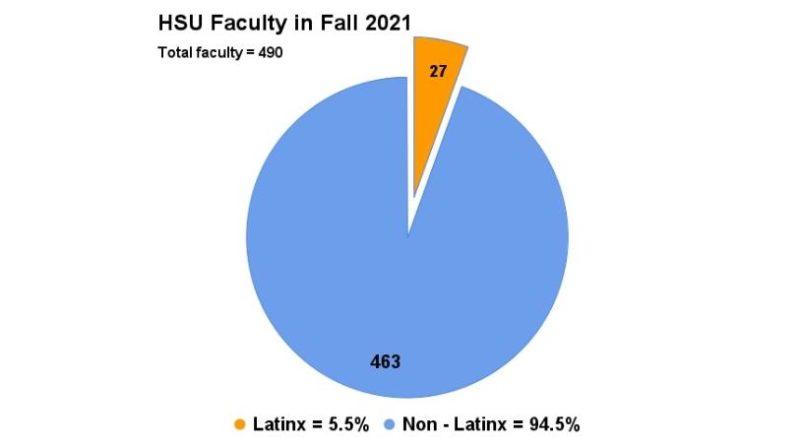Latinx faculty at HSU drops in 2021
HSU is currently considered a Hispanic-Serving Institution
• In 2021, HSU has 27 Latinx faculty out of a total of 490 faculty members.
• In 2013, HSU became a Hispanic-ServingInstitution with more than 25% of undergraduate full-time students identifying as Latinx.
• In 2001, there were 19 Latinx faculty members.
Humboldt State University has 27 Latinx faculty members in 2021, a decrease from 29 in 2020. In the last 20 years, there haven’t been more than 29 Latinx faculty at HSU.
Faculty members who identify as White went from 359 in 2020 to 349 in 2021, a 3% decrease. In 2021, 71% of faculty identified as White at HSU. The Latinx faculty lost a larger percentage, even though they’re already a small percentage on campus.
Incoming Latinx faculty members at HSU have noticed that faculty at the institution isn’t diverse. Which in turn, can steer applicants away if they’re looking to be a part of a diverse work environment.
“As a person who is Latina, you immediately recognize the representation is not there yet,” said Catalina Cuellar-Gempeler, assistant professor of microbiology, cellular and molecular biology, and ecology at HSU. “And I think the University knows it.”
HSU became a Hispanic-Serving Institution (HSI) in 2013 when more than 25% of undergraduate full-time students identified as Latinx. Faculty members believe that the institution recognizing itself as an HSI is not enough. Some Latinx faculty still feel underrepresented and over-looked at HSU, causing some of them to leave.
“We have a number of cases where the Latinx faculty have left our university,” said Rosamel Benavides-Garb, interim dean of the College of Arts, Humanities and Social Sciences in a Oct. 1 interview regarding Latinx identity. “Because we are not a welcoming institution in the sense of providing and meeting the needs of the Latinx faculty.”
The need to freely work in a safe and comfortable workspace, free from microaggressions is necessary for Latinx faculty to thrive and for HSU to retain more faculty over time. The source of these aggressions can come from multiple areas.
“I have noticed Latinos have left and looked for other jobs, and the reason being it’s the microaggressions,” said Marisol Ruiz, associate professor of the School of Education. “Sometimes it’s not from our colleagues, but from our students.”

Cultural Taxation
“There is a lot of research showing that when you have fewer representation of certain groups, those groups of faculties get extra work, called cultural taxation,” Cuellar-Gempeler said. “Students are going to look for you for support when they look like you.”
The work of Latinx faculty members is much more difficult because of students’ limited access to the small number of Latinx faculty.
“The institution is not moving fast enough. The demographics are shifting faster than what the institution can do or able and willing to do,” said Benavides-Garb. “They need to have a deep awareness of the needs of a diverse faculty so the students can see themselves in the faculty – so they can see the faculty as role models.”
According to Benavides-Garb, representation and culture matter in academic settings, and the deficiency at HSU will not only affect the faculty, but the students as well.
“I think it matters a lot. You look up and you see the professors who are teaching you, who are representing the career that you’re going into,” Cuellar-Gempeler said. “Once you see yourself amongst those people it’s easier for you to recognize a position for you in that field.”
Both Cuellar-Gempeler and Ruiz believe that finding individuals that reflect your culture fights the feeling of imposter syndrome, a psychological condition characterized by persistent doubt concerning one’s abilities or accomplishments.
Latinx faculty members worry about the incoming students who will not get the support or time they need from faculty because of the limited number of faculty available.
“I think it’s beneficial to see professors that have different experiences, backgrounds, and look different just so everyone has the opportunity to see themselves becoming the professional they want to be,” Cuellar-Gempeler said. “And realizing that you can bring your culture, bring whoever you are into your professional life and it’s okay. And it actually enriches these environments in academia.”
HSU’s Plan to Increase Diverse Faculty
“In the process of developing a cluster hiring initiative we center diversity, equity and inclusion. As we speak, the working group is still in the process of defining, articulating the requirements, the process that we follow to implement the cluster hiring initiative,” said Elavie Ndura, associate vice president for diversity equity & inclusion and campus diversity officer.
Faculty, like Benavides-Garb, believe that the money has always been there for hiring, but for whatever reason the institution cannot make a difference – the only explanation being that it is a structural issue.
“Some hiring processes did work to a degree, but not fast enough or well enough. We have been able to attract more diverse faculty than previously,” said Simone Aloisio, associate vice president of faculty affairs and academic personnel services. “But we’re not hiring faculty fast enough to put a dent in that number.”
HSU has only gained 11 Latinx faculty members in the past two decades. The institution looks to improve diversity in its faculty with new recruiting plans. The institution looks to cluster hiring initiative, which has had a successful history at Brown University, where they were able to triple the number of African-American faculty in just three years. Currently, HSU is in the process of creating a plan, but it’s not confirmed that the institution will use the cluster hiring initiative.
It feels like a long way for Latinx faculty to have a strong sense of community when there’s been little to no change over the last 20 years. Ndura doesn’t think it’s so easy to transition to a more diverse faculty.
“HSU is strongly committed to increasing the diversity of faculty and staff in an effort – long term – to mirror the diversity of our students. That’s the idea and I have to insist that people understand that such a transformation takes time. You cannot gather all the faculty and say ‘you need to leave your tenure position and we’re going to replace you with a Latinx faculty member.’ It doesn’t work that way,” Ndura said.






